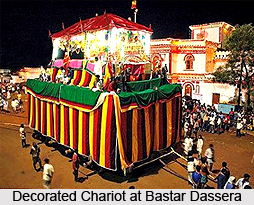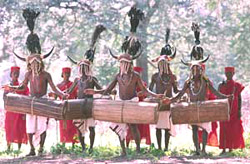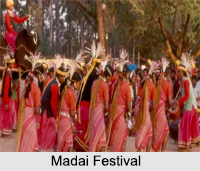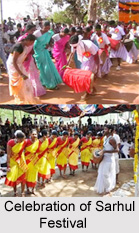 Sarhul festival is one of the important festivals of Oraon tribe. It is celebrated in Jharkhand, especially in the tribal belt. It showcases various colours of life through flowers. Jharkhand draws much attention during this festival. This annual tribal festival is dedicated to the Nature. It is also known as "Ba Parb". "Ba" stands for flower and "Parb" for festival.
Sarhul festival is one of the important festivals of Oraon tribe. It is celebrated in Jharkhand, especially in the tribal belt. It showcases various colours of life through flowers. Jharkhand draws much attention during this festival. This annual tribal festival is dedicated to the Nature. It is also known as "Ba Parb". "Ba" stands for flower and "Parb" for festival.
Significance of Sarhul Festival
The word "Sarhul" holds special significance for the tribe. It is celebrated in the months of March-April in the Gregorian calendar. The Sarhul marks the beginning of the agriculture season. The word Sarhul means "Sar" as Year and "Hul" as Set to commence.
Rituals and Celebrations of Sarhul Festival
In the Sarhul festival, the Oraon Tribe celebrates the holy matrimony of the Earth and the Nature; depicting the masculine race and the feminine race among the numerous living organism in the planet.
On the day of Sarhul festival, they remember `the Great Lord Dharmesh- the Supreme Being` and thank him for the blessings showered on all the living things. The Sarhul festivity is held in the spring season signifying the birth of `new-borns` all around the planet among many living species.
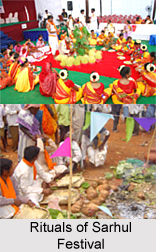 When the Shaal-tree is bustling with the Shaal-flowers, the "Pahan" or the Village Priest and the "Pahanin" (Wife of Head Priest) are symbolically married in the presence of the whole village. This festival also marks the praying for the good monsoon throughout the monsoon months. For that the bucket full of water is poured on to the Pahan`s head. The Shaal-flowers are distributed as prasad (offerings) among the villagers.
When the Shaal-tree is bustling with the Shaal-flowers, the "Pahan" or the Village Priest and the "Pahanin" (Wife of Head Priest) are symbolically married in the presence of the whole village. This festival also marks the praying for the good monsoon throughout the monsoon months. For that the bucket full of water is poured on to the Pahan`s head. The Shaal-flowers are distributed as prasad (offerings) among the villagers.
Sarhul festival is celebrated for two days. The first day is called `Upaas` or the full day fast and the second day is called `Chengna-kati`. On the day of `uppas`, not a single agriculture work is performed in the village. The village-pahan performs fasting. The `dadhi-katna` (the source of drinking water) is properly cleaned in each and every village of the Oraon Tribe. Then the young Oraon boys catch fishes and the crabs; the fish-water is sprinkled in the goshala (cattle-pens) and the fishes are cooked with "bari" (made from cereals). In the night, the Pahan and his companion Pujari fetch the clean water from the dadhi in two earthen pots and keep them under the Shaal-tree. It is known as shakun-panni. The water vessels are guarded throughout the night.
On the day of `chengna-kati`, the women folks of the Oraon tribal village do the fasting. The Pahan carry out the age-old Oraon tribe rituals, perform the puja (formal prayers) and seek blessings for the entire village. After the completion of the formal worship, the Shakun-panni (water in the vessel) is checked. In case the water level is still good, then good monsoon season is anticipated. In case, the environment is full of humidity then the water level rises and in case it is very hot the water dries out.
The Pahan and his associates go around every home in the village and distribute Shakun-Pani (Shakun-water) and Sarna-Phool (Sarna-flower) there. Finally on the night of the Chengan-Katti, the community dance and feast program starts. This night is called Khaddi.
As per the ritual, a bird like fowl is sacrificed as an offering to the Goddess Adishakti (the incarnation of Goddess Vaishno devi) at the Sharan Sthala to seek her blessings. It is believed that the Saal tree is the abode of the Goddess. Once the Puja is over, the offerings to the Goddess are distributed among all devotees.


